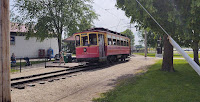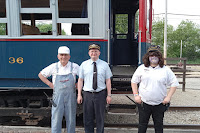The Chicago Aurora & DeKalb Railroad
by Stephen M. Scalzo
Headline image: Coach 22 and freight motor 21 meet at the Bliss siding halfway between Aurora and Kaneville in August 1914. All photos are from the Stephen Scalzo Collection of the Illinois Railway Museum except where noted.
The Chicago DeKalb & Rockford Electric Traction Company (CD&RET) was incorporated on December, 1901, by P.H. Batten and Company of Chicago, and plans were developed to initially build a 27-mile interurban line between Aurora and DeKalb. The survey of the line had the right-of-way going northwest from Aurora to Kaneville, Cortland, Maple Park, and DeKalb, home of Northern Illinois University. In May of 1902, the company was granted a franchise to use the streets of Aurora. By December 1904, 15 miles of grading was completed, and tracklaying began shortly thereafter by the William C. Ross Company of Chicago which had been awarded the construction contract on October 1. During 1905, 19 miles of trackage was completed from Aurora to Kaneville before the contractor discovered that his bid was too low, and promptly went broke and out of business. Joy Morton of salt fame came to the rescue, and construction was completed by June 30, 1906, to the university in DeKalb. A small carbarn was constructed in Aurora.

The early gas-powered passenger fleet consisted of diminutive cars resembling speeders and cars like CD&RET car 7, shown here, that were basically streetcars. Car 7 resembles a Brill product but it does not show up in Brill, American, Kuhlman, or Danville order lists, and its actual builder is unknown.
Locomotive 1 is at the west end of the line in DeKalb with a distinctively ex-CB&Q coach in tow.
The company had a great deal of trouble securing entrance into Aurora because the local streetcar company initially did not want to provide 1.5 miles of trackage rights. The first passenger operations were planned with electric operation, and after the overhead wires were installed, the company decided instead to use gasoline motorcars and the overhead was dismantled. Two 100hp 40passenger motorcars were ordered, and on January 1, 1907, passenger service began. Those cars initially operated two round tripos a day over the line, which required 90 minutes for the trip. Freight service was operated by steam locomotives. The line had no passing sidings, so when a motor car met a freight train, it was necessary for the passengers to disembark while the crew lifted the car off the tracks to let the freight pass. Eventually, six motorcars were used to provide passenger service, however those cars proved unsuccessful and were scrapped after several years. Several secondhand passenger coaches were then purchased and hauled behind a steam locomotive. During 1908, the company carried 20,000 passengers and earned $10,809 (negative $5,448), and those poor earnings forced the company into bankruptcy and receivership on August 31, 1908.
This photo may have been taken around 1910, as it depicts what appears to be a mixed train at Kaneville yet engine 1 is lettered CA&D. It's also possible, however, that this is post-electrification.
Car 24 is traveling down the middle of the street in Kaneville, likely sometime in the 1910s. Of the four buildings visible in this picture, taken looking northwest at Harter and Main Street, three still stand.
The Chicago Aurora & DeKalb Railroad was organized on July 21, 1909, and on October 29, 1909, it purchased the AD&RET at a foreclosure sale for $95,000. Plans were immediately developed to electrify the line, and three passenger and two freight box motor interurbans patterned after the equipment of the nearby
Joliet & Southern Traction Company were ordered. Substations were constructed at Kaneville and Cortland. Plans were also developed to extend trackage 31 miles to Rockford; however nothing ever was constructed. The 600-volt DC electrification was completed in August of 1910, and interurban passenger service began operating on August 14 with seven daily trains on 90-minute schedules. When an additional five interurbans arrived in 1911 [sic], 12 daily round trips were operated, with 85 minutes needed to make a full trip between terminals.

Around 1920, central Aurora served four interurban lines radiating in five directions from the city, more than any other downtown in Illinois - even Chicago, whose Loop was only served by two interurban companies at that time. Here, CA&D 22 is turning from Main Street (today Galena Blvd.) onto Broadway in downtown Aurora. It's being followed by two Aurora Elgin & Chicago suburban cars, the latter an ex-Twin City car purchased by the AE&C in 1913. The dome in the right background is today the site of the Paramount Theatre.
Car 22 is shown standing in front of the substation at Kaneville, barely visible in the right background. This structure stood for several decades after the interurban quit but is long gone now. A different print of this photo that shows more of the substation is here.
Electrification did not prove the stimulus to the passenger traffic problem; passenger traffic had been weak from the beginning, and that pattern continued to hold true. The company was soon operating unprofitably and bankruptcy came on September 2, 1913. The company was reorganized on March 31, 1917, but a second bankruptcy occurred on January 15, 1918, when the severe winter of that year drastically cut ridership. By 1922, service had been reduced to seven daily round trips, with earnings of $62,738 (negative $2,045). Inroads were already being made by private automobiles and the construction of concrete highways in the area. Seeing that the company could not be operated profitably, the receiver determined that continued operations would be fruitless and the decision was made to discontinue all service. The last interurban operated on January 31, 1923, which was the first significant Illinois interurban line to be abandoned. Efforts were made by the local farmers over the next several months to restore service, but at the foreclosure sale, the highest bid of $90,000 was from scrap dealer Israel Joseph, who dismantled the line after receiving permission from the Illinois Commerce Commission in September of 1923.
This article was edited and laid out by Frank Hicks. Thanks to Ray and Julie Piesciuk and to Richard Schauer for making available the materials from the Stephen Scalzo Collection that were used to publish this history.
Chicago Aurora & DeKalb Equipment Roster
This roster is incomplete
Non-electric cars:
1, 2 (two steam locomotives) - 4-4-0 steam engines - purchased c1907 secondhand from the CB&Q
? (as many as five cars) - gas-powered motor cars, some rebuilt from automobiles or trucks, at least one (numbered 7) was a DE ST DR car
6, 8 (two cars) - DE ST DR semi-convertibles - built 1907 by Kuhlman (ord#351) - Brill 21E trucks
? (at least two cars) - open-platform coaches - purchased c1909 secondhand, at least one car ex-CB&Q
302 (MOW flatcar) - weed killer (
photo)
Electric cars:
22, 24, 26? (three cars) - DE DT RR interurban coaches - built 1910 by Danville (ord#543) - numbers uncertain, Danville records list car 26 and two others, some sources say 22 and 24 were built by American but that company's records don't show any cars built for the CA&D - car 26 wrecked in collision with C&NW on east side of DeKalb; car 24 given to Elgin & Belvidere early 1920s to replace E&B car 205, wrecked while on loan to CA&D
21 (one car) - DE DT freight motor - built 1909 - some sources say built by American but that company's records don't show it; it's also possible that there were two cars of this type on the CA&D - sold to E&B c1923 (possibly as
E&B 103?)
Chicago Aurora & DeKalb Route Map
The most easily identifiable remnants of the CA&D today are spots where the right-of-way is still evident, notably through Bliss Woods west of Aurora, where May Road and a walking path sit on the interurban alignment; and the carbarn in Aurora, a small two-story building at the southwest corner of Plum Street and the ex-CB&Q line to Batavia (
Google Street view image).
Chicago Aurora & DeKalb Photo Album
Westbound steam locomotive 1 has a CB&Q stock car and a few other freight cars in tow in this picture taken looking southeast from the corner of Main Street and Harter in Kaneville.
The only cars in the gas-powered fleet that are well documented were cars 6 and 8, built by Kuhlman in 1907 as shown here. These cars had a two- or possibly even three-tone paint scheme, as is evident in this builder's photo, but what these colors were is not certain.
Express car 21 is shown on some sort of special trip on the straightaway through Bliss Woods west of Aurora. This area is today a forest preserve and the interurban right-of-way is a walking path.
Interurban cars 22 and 24 meet at the siding at Kaneville. The CA&D was single-track with sidings at four locations, all single-ended: (east to west) Bliss, Kaneville, Watson, and Cortland.


















































